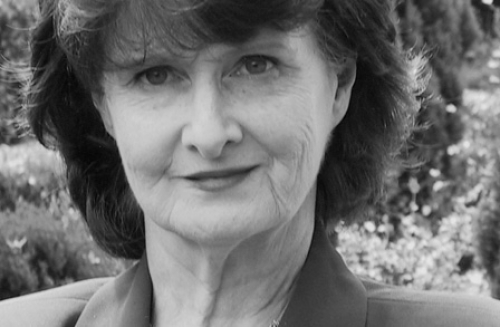'The life I lived was a woman's life': Eavan Boland, one of Ireland's finest poets

Jenny Farrell remembers the life and work of the late Eavan Boland
Eavan Boland died on 27 April 2020. She ranks among Ireland’s finest poets, and was one of the foremost female voices in Irish poetry. She was born in Dublin in 1944, her father a diplomat and her mother a painter. She published the first of many collections, 23 Poems, in 1962 while still a student at Trinity College in Dublin. Her early work tells of her experiences as a young mother, and her growing awareness of the role of women in Irish history. She commented in an interview:
I began to write in an Ireland where the word ‘woman’ and the word ‘poet’ seemed to be in some sort of magnetic opposition to each other. Ireland was a country with a compelling past, and the word ‘woman’ invoked all kinds of images of communality which were thought to be contrary to the life of anarchic individualism invoked by the word ‘poet’….I wanted to put the life I lived into the poem I wrote. And the life I lived was a woman’s life. And I couldn’t accept the possibility that the life of the woman would not, or could not, be named in the poetry of my own nation.
So Eavan Boland wrote about the many subjects that she experienced, as a woman and as a human being – and this included historical and political themes. She worked as a poet, editor and teacher. In later years, Boland was Professor of English and director of the creative writing programme at Stanford University. In 2017, she received the Lifetime Achievement Award at the Irish Book Awards.
A favourite poem of mine is one written in 1975, at the height of the Troubles:
The War Horse
This dry night, nothing unusual
About the clip, clop, casual
Iron of his shoes as he stamps death
Like a mint on the innocent coinage of earth.
I lift the window, watch the ambling feather
Of hock and fetlock, loosed from its daily tether
In the tinker camp on the Enniskerry Road,
Pass, his breath hissing, his snuffling head
Down. He is gone. No great harm is done.
Only a leaf of our laurel hedge is torn –
Of distant interest like a maimed limb,
Only a rose which now will never climb
The stone of our house, expendable, a mere
Line of defence against him, a volunteer
You might say, only a crocus, its bulbous head
Blown from growth, one of the screamless dead.
But we, we are safe, our unformed fear
Of fierce commitment gone; why should we care
If a rose, a hedge, a crocus are uprooted
Like corpses, remote, crushed, mutilated?
He stumbles on like a rumour of war, huge
Threatening. Neighbours use the subterfuge
Of curtains. He stumbles down our short street
Thankfully passing us. I pause, wait,
Then to breathe relief lean on the sill
And for a second only my blood is still
With atavism. That rose he smashed frays
Ribboned across our hedge, recalling days
Of burned countryside, illicit braid:
A cause ruined before, a world betrayed.
“The War Horse” is an ominous title, especially when we place ourselves in the time it was written. The Troubles brought daily deaths and terrible suffering. This poem challenges Southern Irish society’s turning of a blind eye across the border. This is one of several poems where Boland tackles Southern indifference during these years.
The title suggests power, masculinity and military force. War horses were usually stallions, bred and raised from foalhood to meet the needs of war. In contrast to the unease created by the title, the reader is told there is: “nothing unusual/ About the clip, clop”, something that alerts the reader to there being something “unusual”. Clip, clop enacts the sound of the hooves on the street. Run-on lines throughout poem somehow seem to contradict its rhyming
couplets. They suggest that what is being related is not neat and tidy, but bursts out of this apparent control.
The “casual// Iron of his shoes as he stamps death”, evokes violence, heightened in “coinage” suggesting carnage. The level stress in “stamps death” suggests a horse or a soldier in battle. At the same time, the image is linked to the making of money and the violation of the earth. The rhyming of death and earth emphasises that all is not is well.
The speaker opens her sash window, exposing herself to the experience. The horse comes closer and more into focus. The description moves from the general distant appearance to more specific details: “the ambling feather/ Of hock and fetlock” – the long hair on the lower legs, ‘hock’ referring to the hind leg knee and ‘fetlock’ being the horse’s ankle. The horse, the reader is told, is freed from being tied up in the “tinker camp”. The speaker focuses first on the animal’s legs, then its freedom and his “breath” and “snuffling head”.
The horse passes. And apprehension changes to relief. Yet, the proximity of this war horse has had an effect on the speaker’s space, even in suburbia. Two caesuras slice the line. “No great harm is done” alerts reader to harm! “Only a leaf of our laurel hedge is torn”. The choice of the leaf, “laurel”, connotes triumph, glory and peace but also funeral wreaths. The next line initially continues the idea of distance to the horse: “Of distant interest” but as the line progresses, this distance cannot be maintained. War in a remote place suddenly becomes vivid and fighting: “maimed limb” comes as a huge shock. It contradicts “distant interest”.
The reader is forced to reflect. This absence of emotional distance is underlined by the next image, the “rose” that “will never climb/ … our house”: the rose signifies beauty and a life destroyed before its flower and “our house” is more than the immediate home of the speaker.
It comes to represent Ireland. The promise of life and beauty stamped out is given the specific 20th century Irish reference “volunteer”. This one rose, the speaker states, is “expendable, a mere/ Line of defence against him, a volunteer/ You might say”. However, the reader is unconvinced. The emotional weight of the imagery is on the side of this victim who is anything but “expendable”.
This emotion is greatly intensified in the next image: “only a crocus, its bulbous head/ Blown from growth, one of the screamless dead.” Again, the word “only” belies the speaker’s empathy. The “bulbous head” evokes human heads, even skulls, and “Blown from growth” the violent killings of very young people, not even fully grown, by guns and explosives. The image of “screamless dead” seems to suggest the opposite – terrible screams. It adds sound to an already horrifying image.
Developed from the apparently small damage done by the war horse to the speaker’s hedging and garden, there has emerged a build-up of intense feeling for the youth and the dead of Ireland, indeed the world affected by war. Neither the rose nor the crocus will flower. O-sounds dominate, communicating deep sadness.
Following this intensity of feeling, the speaker addresses in similarly ironic tone her fellow dwellers in suburbia: “But we, we are safe, our unformed fear/ Of fierce commitment gone”. Neighbours hiding behind curtains, pretending not to know what is going on, afraid of the commitment and sacrifice made by others involved in conflict and war, and believing that turning away from suffering will somehow protect them from it. The speaker has opened the window and thereby herself to this experience and the grief it brings to her, while the others hide behind “curtains”.
Now the voices of neighbours are brought in: “why should we care// If a rose, a hedge, a crocus are uprooted/ Like corpses, remote, crushed, mutilated?” Boland exposes these people’s indifference by recapturing the terrible violence. This highlights suburbia’s attitude, where nothing matters unless it affects their own gardens. The speaker points out how the horse, by passing her garden does affect it; and this becomes an image for Ireland. The flowers are depicted as a very fragile line of defence against a powerful horse.
The speaker, too, is grateful that war has passed her house, but “atavism” reminds her that war has damaged Ireland: “for a second only my blood is still// With atavism”. The word “still” has two meanings here: still with shock, and still in touch with the past (atavism). What was sensed before now becomes explicitly clear to her: the rose that was crushed is scattered across the hedge and reminds her of the violence past and present in Ireland.
The final images bring us back to the “rose” that “frays/ Ribboned across our hedge”. The past (the Ribbonmen, an agrarian secret society who burned the countryside) and the present come together here surrounding “our house”. Ireland, and indeed the world cannot and must not ignore the devastation war brings. In the long run, nobody can pretend not to know.

Jenny Farrell
Jenny Farrell is a lecturer, writer and an Associate Editor of Culture Matters.
Latest from Jenny Farrell
- Poetry for the Many, an anthology by Jeremy Corbyn and Len McCluskey
- A hopeful vision of human renewal: the theatre of Seán O'Casey
- Art that's rooted in the upheavals of his time: Caspar David Friedrich, 1774-1840
- A Drive to Change the World: James Baldwin, Black Author, Socialist and Activist
- A woman's perspective on the invisible front: A review of 'The Shadow in the Shadow'
